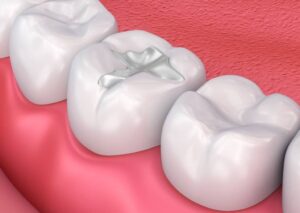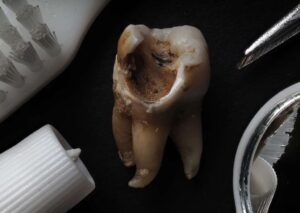

253 Happy Customers On Google
A small gap between your teeth might seem harmless or even cute. But depending on the size, location, and cause, that space could have more to do with your oral health than you think. At Fresh Dental Care Kepong, we often get questions like “Do I really need to fix this?” or “Can a gap affect my bite?” Here’s the full story.
Why Gaps Between Teeth Occur?
 Genetics
Genetics
Yes, some people are simply born with them. If your parents or siblings have noticeable gaps between their teeth, chances are you might too. These inherited traits often include jaw size, tooth size, or both – which can result in extra space between teeth.
Gum Issues or Overgrowth
Excess gum tissue can push teeth apart or create spacing. In some cases, an oversized labial frenum – the small fold of skin between your upper lip and gums – can also contribute to gaps, especially between your front teeth.
Thumb-sucking & Childhood Habits
Long-term thumb-sucking or prolonged pacifier use can shift your front teeth forward, making room for gaps. If not corrected early, the spacing can become permanent and may need orthodontic intervention.
Missing Teeth or Jaw Size Differences
Sometimes gaps appear because teeth never developed in certain spots or were lost due to decay or injury. If your jaw is too large for your teeth, it can leave extra space – especially near the canines or molars.
Natural Shifting from Poor Oral Habits
Teeth can move naturally over time. Bad oral habits like tongue thrusting, teeth grinding, or inconsistent flossing can gradually widen spaces, leading to a gap that wasn’t always there.
Can Teeth Gaps Really Harm Your Oral Health?
 Impact on Gum Health (Inflammation Risk)
Impact on Gum Health (Inflammation Risk)
Gaps can expose more surface area of your gums. This makes it easier for food to get trapped and harder to clean properly, which raises your risk of gum irritation, inflammation, and even gum disease if left untreated.
Difficulty in Chewing or Speech Clarity
Teeth gaps can interfere with how you pronounce certain words or sounds. They can also affect how your teeth bite down, causing discomfort when chewing or biting into hard foods.
How Spacing Leads to Plaque Traps & Cavities
The bigger the space, the easier it is for food debris to hide. If those areas aren’t cleaned well, plaque builds up. Over time, this increases the chance of decay forming around or in between those teeth.
Can It Affect Your Bite and Jaw Alignment?
Yes. When teeth don’t line up properly, it can strain your jaw muscles and joints. Over time, this misalignment can lead to TMJ issues, headaches, or uneven tooth wear – even if the gap seems small.
How to Fix a Gap in Your Teeth
 Dental Bonding – Fast fix for mild gaps
Dental Bonding – Fast fix for mild gaps
This is one of the most common and affordable solutions. Your dentist applies a tooth-colored resin to close the gap and shapes it to blend in naturally. It’s painless, quick, and often done in one visit.
Veneers – For cosmetic perfection
For larger gaps or people wanting a flawless smile, porcelain veneers offer a long-lasting and aesthetic solution. These custom-made shells go over your natural teeth and can reshape your entire smile.
Clear Aligners & Self-Ligating Braces
If your gap is part of a bigger alignment issue, orthodontic options like Invisalign or self-ligating metal braces can gradually move teeth into the right position. These are ideal for teens and adults who want subtle, effective treatment.
Read more: Self-Ligating Braces in Malaysia: What You Need to Know
Retainers – Great for small, shifting gaps
Sometimes, a simple removable retainer can help bring teeth closer together. It’s best for minor gaps or to prevent gaps from reopening after other treatments.
Can Rubber Bands Close Teeth Gaps?
Rubber bands – often used with braces – apply gentle pressure to guide teeth closer. But using them at home without supervision is risky and not recommended. Only a licensed orthodontist should prescribe and manage rubber band treatments.
How to Fix Teeth Gap Naturally – What Actually Works?
Some mild gaps may improve slightly through natural growth changes, but most require professional care. Exercises like tongue placement or posture won’t shift teeth significantly. Natural oils or remedies have no evidence-backed effect.
Why You Shouldn’t Try DIY Braces at Home
It might be tempting to try hacks seen online – like using hair ties or DIY kits – but these can damage your gums, loosen healthy teeth, or lead to infection. Always consult a dentist for safe, science-backed options.
Read more: Conventional Braces vs Self-Ligating Braces
Common Teeth Gap Scenarios (And What To Do)
 Gaps Only Between Front Teeth
Gaps Only Between Front Teeth
These are the most common and often the most noticeable. Solutions range from bonding and veneers to aligners, depending on size and cause.
Gaps Near Canines or Uneven Sides
When gaps are asymmetrical or only on one side, it may signal jaw misalignment or missing teeth. A thorough assessment is needed to choose between braces or dental prosthetics.
Multiple Small Gaps All Over
This type of spacing often suggests a mismatch between tooth and jaw size. Invisalign or full-mouth orthodontics may be the most effective treatment.
Gaps Due to Missing Molars or Shifting
Back teeth support bite function. If there are gaps from extractions or molar loss, it can lead to collapse of nearby teeth. Dental bridges, implants, or partial dentures may be needed.
Does Flossing Create Gaps in Teeth?
Debunking Myths Around Dental Floss
No, flossing doesn’t cause gaps. If anything, it helps prevent them. What you might notice is that after removing plaque, teeth feel looser or more spaced – but that’s temporary.
What’s Normal vs. What’s Problematic
If flossing reveals new gaps or if your teeth feel like they’re shifting, it could be a sign of gum recession or bone loss. In this case, see your dentist right away.
How Long Does It Take to Close Teeth Gaps?
Treatment Timelines: Bonding vs Aligners vs Braces
Bonding can be done in one session. Veneers might take 2-3 appointments. Aligners and braces take longer – usually 6 months to 2 years – depending on the severity.
What Determines Speed of Results
Factors include gap size, type of treatment, patient age, and how consistently instructions are followed. Regular follow-ups ensure smoother progress.
Read more: Invisalign vs. Braces: Which is the Better Option for Malaysians?
FAQ – Your Top Questions Answered
Can I fix gaps between teeth without braces?
Absolutely. Depending on the size and cause of the gap, options like dental bonding, veneers, or retainers can help close it without needing full braces. Your dentist can recommend the best solution based on your needs.
Can teeth gaps close naturally?
Rarely. Minor gaps may close with growth in young children, but adults typically need dental intervention.
Is it ok to leave a gap in your teeth?
In some cases, yes. Small gaps that don’t interfere with chewing, speech, or gum health may not require treatment. But it’s important to get evaluated by a dentist to rule out underlying issues like gum disease, bite misalignment, or bone loss.
What’s the safest way to close a front tooth gap?
Bonding and Invisalign are among the safest and most effective options. Consult a dentist to explore your choices.
Are gaps between teeth always a dental concern?
Not always. Some gaps are harmless, but many can lead to alignment issues or oral hygiene challenges. It depends on your specific case.
Ready to Fix That Gap? Let’s Talk.
If your tooth gap has been bothering you – whether for cosmetic or health reasons – we’re here to help. Book a consultation at Fresh Dental Care Kepong today.
Let’s find the right treatment for your smile. Chat with us now on WhatsApp or drop by the clinic for a friendly, professional assessment.


 Genetics
Genetics  Impact on Gum Health (Inflammation Risk)
Impact on Gum Health (Inflammation Risk) Dental Bonding – Fast fix for mild gaps
Dental Bonding – Fast fix for mild gaps Gaps Only Between Front Teeth
Gaps Only Between Front Teeth


